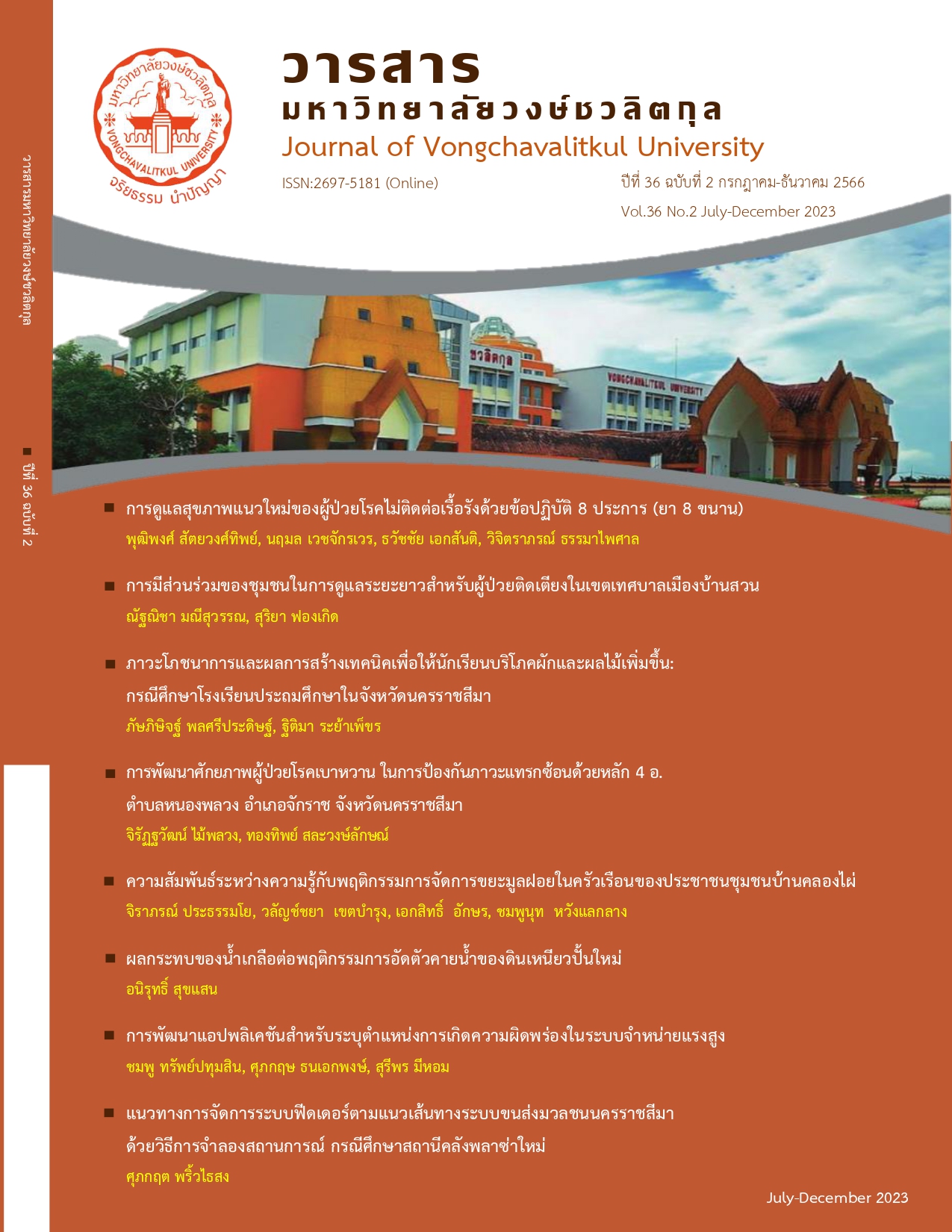Nutrition Status and Results of Techniques Creating to Increase Fruit and Vegetable Consumption for Students: A Case Study in an Elementary School of Nakhon Ratchasima Province
Main Article Content
Abstract
Objective: This study aimed to evaluate nutritional status and to study the results of strategies or techniques applying to promote an increasing of vegetable and fruit consumption at lunch.
Methods: The research was a participatory action research design. The target group were 84 students studying in kindergarten to elementary class in academic year 2022. Three instruments used in this study were (1) weighing scale, and height measuring device for nutritional status assessment; (2) the evaluation form for vegetable and fruit consumption behavior of student; and (3) AICE technique to increase participation of related person. Data were analyzed using descriptive statistic and Fisher’s exact test.
Results: The results showed that the average age of the students was 9 years old. The nutritional status before and after the study were displayed. Seventy three point eight (73.8%, before) and 76.2% (after) of the students were in normal range, 13.1% and 11.9% were obese, 10.7% and 9.5% were thin, and 2.4% were in short stature level. Regarding the vegetable and fruit consumption, it was found that before the study, 48.8% of the students did not consume, whereas, 38.1% consumed but insufficient, and only 13.1% consumed sufficiently. After creating and implementing the 9 techniques to encourage more vegetable and fruit consumption, the rate of students not consuming fruit and vegetable decreased to only 33.3%, the rate of insufficient consumption increased to 50.0%, and sufficient consumption increased to 16.7%. However, the increasing of fruit and vegetable consumption was not statistically significant different. Therefore, to continually improve in consumption behavior of students, it is necessary to bring health related technology to be used as well, The improvement intervention included the determination of problems resolutions or individual development resolutions along with social or environmental development. The improvement intervention should be conducted with regard to the important factors such as monitoring, control, duration, continuity, and cooperation of stakeholders.
Article Details

This work is licensed under a Creative Commons Attribution-NonCommercial-NoDerivatives 4.0 International License.
References
จักรพันธ์ เพ็ชรภูมิ. (2562). พฤติกรรมสุขภาพ แนวคิด ทฤษฎีและการประยุกต์ใช้. พิมพ์ครั้งที่3. พิษณุโลก: สำนักพิมพ์มหาวิทยาลัยนเรศวร. สืบค้น 4 กุมภาพันธ์ 2565, จาก https://www.nupress.grad.nu.ac.th/shop/wp-content/uploads/2017/07 /พฤติกรรมสุขภาพ.pdf
ดวงใจ ลิมตโสภณ, สุทธดา ตั้งอยู่ดี. (2564). ผลของโปรแกรมการส่งเสริมการบริโภคผักผลไม้ต่อความรู้พฤติกรรมและปริมาณการบริโภคผักผลไม้ และภาวะโภชนาการของนักเรียน ชั้นประถมศึกษาตอนปลายโรงเรียนสังกัดสำนักการศึกษาพื้นฐาน กรุงเทพมหานคร. วารสารคณะพยาบาลศาสตร์ มหาวิทยาลัยบูรพา, 29(3), 41-53.
ปาณัสม์ สุบงกช, สมบูรณ์ จิระสถิตย์, ณัฐกฤตา ศิริโสภณ, สมบัติ อ่อนศิริ, อลิสา นิติธรรม. (2562). ประสิทธิผลของโปรแกรมสุขศึกษาเพื่อปรับเปลี่ยนพฤติกรรมการบริโภคอาหารของนักเรียนที่มีภาวะโภชนาการเกินเกณฑ์มาตรฐานในระดับชั้นประถมศึกษาตอนปลายโรงเรียนวัดกลางคลองสี่ จังหวัดปทุมธานี. วารสารสุขศึกษา พลศึกษา และสันทนาการ, 45(2), 100-110.
สถาบันวิจัยประชากรและสังคม มหาวิทยาลัยมหิดล. (2562). รายงานการติดตามพฤติกรรมการกินผักและผลไม้ของคนไทย ปี 2561. สืบค้น 4 กุมภาพันธ์ 2565, จาก https://dol.thaihealth.or.th/ Media/Pdfview/7c49dbf6-55fd-ea11-80ec-00155d09b41f)
สาธิต เมืองสมบูรณ์, ทวีศักดิ์ เตชะเกรียงไกร, พรทิพย์ พสุกมลเศรษฐ์, และคณะ. (2562). ผลของตำรับอาหารไทยมื้อกลางวันที่มีต่อภาวะโภชนาการของเด็กวัยเรียน: กรณีศึกษาโรงเรียนสังกัดสำนักงานเขตพื้นที่การศึกษาประถมศึกษานครนายก. วารสารวิทยาลัยดุสิตธานี, 13(1), 284-301.
สำนักโภชนาการ กรมอนามัย กระทรวงสาธารณสุข. (2564). รายงานผลการวิเคราะห์ตามตัวชี้วัด 1.11ร้อยละของเด็กอายุ 6-14 ปี สูงดีสมส่วน รอบ 5 เดือนแรก ปี 2564. สืบค้น 4 กุมภาพันธ์ 2565, จาก https://nutrition2.anamai.moph.go.th/ web-pload/6x22caac0452648c8dd 1f534819ba2f16c/filecenter/file/doc/ 2564-1.11.pdf.
สำนักงานสาธารณสุขจังหวัดนครราชสีมา. (2564). รายงานอนามัยโรงเรียน ปี 2564. สืบค้น 5 กุมภาพันธ์2564, จาก https://nma.hdc.moph.go.th/hdc/reports/report_student.php?cat_id=67f8b1657bc8c796274fb9b6ad5a701d&id=76830adec6c892ee56a56938208d1460
สุชาดา พิชัยธรรม, ยุวยงค์ จันทรวิจิตร, อุมาพร ห่านรุ่งชโรทร. (2563). ความสัมพันธ์ระหว่างปัจจัยครอบครัวและรูปแบบการอบรมเลี้ยงดูของผู้ปกครองกับภาวะโภชนาการของนักเรียน ชั้นประถมศึกษาปีที่ 4 - 6 ของโรงเรียนสังกัดสํานักงานคณะกรรมการการศึกษาขั้นพื้นฐาน อําเภอเมือง จังหวัดพิษณุโลก. พยาบาลสาร, 47(4). 88-99.
ศูนย์พัฒนาองค์ความรู้ด้านกิจกรรมทางกายประเทศไทย (ทีแพค) สถาบันวิจัยประชากรและสังคมมหาวิทยาลัยมหิดล. (2564). ข้อเสนอเชิงนโยบายเพื่อการดำเนินงานโรงเรียนส่งเสริมกิจกรรมทางกายในประเทศไทย. สืบค้น 5 กุมภาพันธ์ 2564, จากhttps://dol.thaihealth.or.th/Media/Pdfview/2bd3c898-1898-eb11-80ec-00155d09b41f)
Poelman, Astrid A. M., Cochet-Broch, M., Wiggins, B., McCrea, R., Heffernan, J. E., Beelen, J., and Cox, D. N. (2020). Effect of Experiential Vegetable Education Program on Mediating Factors of Vegetable Consumption in Australian Primary School Students: A Cluster-Randomized Controlled Trial. สืบค้น 5 กุมภาพันธ์ 2564, จาก https://www.mdpi.com/2072-6643/12/8/2343.
Ndagire, C. T., Muyonga, J. H., & Nakimbugwe, D. (2020). Fruit and vegetable consumption, leisure-time physical activity, and sedentary behavior among children and adolescent students in Uganda. สืบค้น 5 กุมภาพันธ์ 2564, จาก https://onlinelibrary.wiley.com/doi/full/10.1002/fsn3.883.
Cohen, J. F. W., Hecht, A. A., Hager, E. R., Turner, L., Burkholder, K., and Schwartz, M. B. (2020). Strategies to Improve School Meal Consumption: A Systematic Review. สืบค้น 5 กุมภาพันธ์ 2564, จาก https://www.mdpi.com/ 2072-6643/13/10/3520.
Sukanya Buasri, Kamoltrip Thipsungwan, Anong Suntranon. (2020). Food Consumption Behaviors, Fruits and Vegetables Among School-aged Children in Chiang Rai Province. Nursing Journal, 47(2). 24-36.


